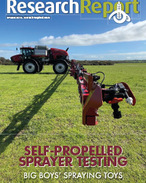This article is 8 years old. Images might not display.
The Cotton Research and Development Corporation (CRDC) and NSW Department of Primary Industries (DPI), in partnership with Murrumbidgee Irrigation and the University of Queensland, has successfully applied for funding under the ‘Control tools and technology for established pests, animals and weeds competitive grants program’.
Stacey Vogel, a natural resource management technical specialist with CottonInfo, the Australian cotton industry’s national extension team, explained to Farming Ahead how the project aims to tackle the weed.
“We want to use this two-year project to develop a bio-herbicide for species and/or hybrids within the Noogoora burr species complex, using an existing, naturally occurring fungal pathogen agent, Alternaria zinniae,” she says.
“There’s some taxonomic confusion around the morphological difference between the species and hybrids within the Noogoora burr complex, so we’re going to do some DNA sequencing to help clarify the difference between species to ensure there’s efficacy of the pathogen agent we hope to use in the future.”
One of the reasons the cotton industry has partnered on this project is that Noogoora burr also hosts some of the pest insect species that impact cotton and, from a stewardship point of view, it’s an environmental weed in cotton landscapes.
“Noogoora burr has also been found to host a disease called Verticillium Wilt (Verticillium dahlia), which has quite a big impact on cotton yields,” Ms Vogel explains.
“The project will also involve DNA work to look at whether all species within the complex host Verticillium Wilt, so we can understand more fully the impact of the weed.”
NSW DPI and CRDC will be sampling and testing different Noogoora burr species around the country and work on the potential pathogen solution.
The University of Queensland is involved with the project’s DNA sequencing work, while Murrumbidgee Irrigation will assist with field trials/sampling, extension and industry linkage.
“If preliminary field trials over the next two-years of the project successfully show that this pathogen can be an effective bio-herbicide to combat Noogoora burr, a larger longer-term project will need to be developed for broader landscape application,” Ms Vogel says.























